Introduction
While the Japanese equity market managed to strongly rebound in 2020 after a sharp fall at the start of the pandemic, it has lagged its peers in 2021 amid the country’s struggle to contain COVID-19 and its slow rollout of vaccinations. However, the rollout of vaccines is gathering pace after a slow start. Japan’s dividend yields are also showing potential appeal amid a rising interest rate environment.
Despite initial post-COVID-19 recovery, 4th infection wave looms over Japan stocks
The Japanese equity was hit hard by the outbreak of the COVID-19 pandemic at the start of 2020 and dropped sharply in tandem with its global peers. Japanese equities kept abreast with a subsequent rebound by global markets enabled by aggressive monetary and fiscal policies in large economies, notably the US. By 4Q 2020, the Japanese equity market had recovered to its pre-pandemic level, thanks in part to its relatively low level of coronavirus cases, which did not require strict lockdown measures that were taken in other parts of the world. A recovery in external demand from the US and China, Japan’s two largest trading partners, also boosted the recovery and the domestic equity market performed strongly in 2020.
Chart 1: Returns from major developed markets since 2020
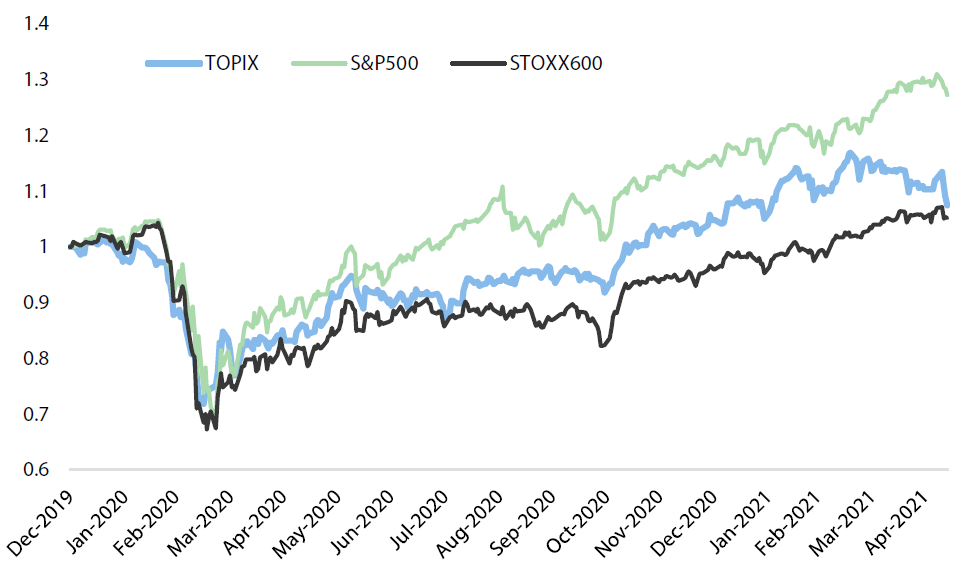 Source: Bloomberg, as at 13 May 2021
Source: Bloomberg, as at 13 May 2021
The specific factors that contributed to the rebound by Japan’s TOPIX index are summarised in Chart 2. We have split the time horizon into two parts. The blue bars indicate the sector return contribution in 2020 and the orange bars indicate the same contributions made so far year-to-date. The green line indicates the contributions for the entire period.
Chart 2: Sector contributions for TOPIX since 2020
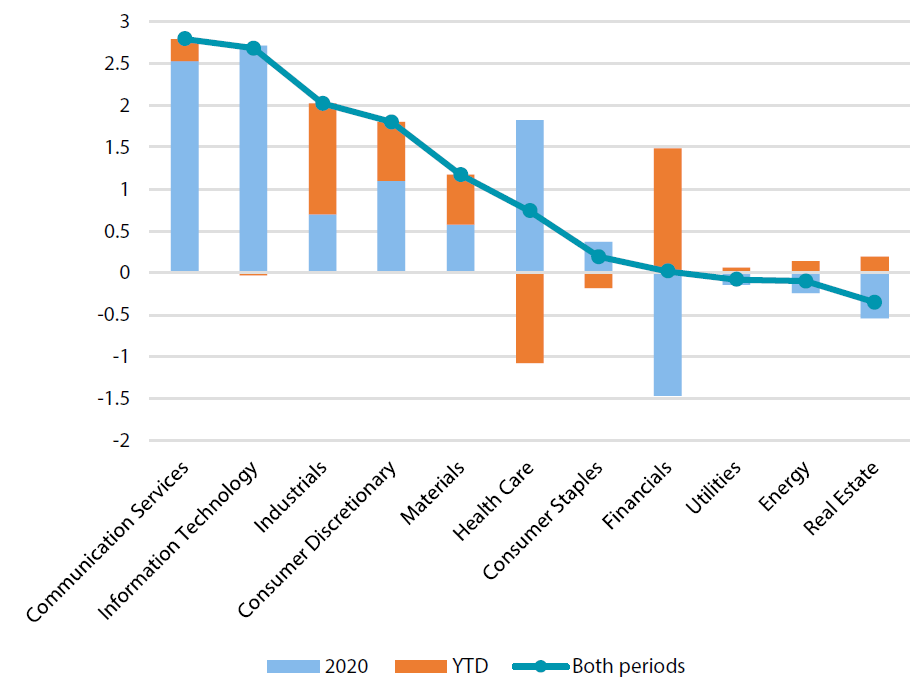 Source: Bloomberg, as at 13 May 2021
Source: Bloomberg, as at 13 May 2021
We highlight three key observations from Chart 2. 1. The Japanese equity market’s strong performance in 2020 was driven by IT and Communication Services (which includes software & other IT service companies), while Financials were a drag due to expectations that interest rates would remain low. 2. Sectors such as Financials, Real Estate, Utilities and Energy followed identical patterns. These sectors were hit hard by the pandemic in 2020 but have been rebounding since the beginning of 2021. This is due to a shift in the market which led to sector rotation, with investors picking up some stocks that had been oversold. 3. Technology names have been quiet so far in 2021. Despite a strong start to 1Q, recent weakness in the market has wiped out all the gains. We think that the Japanese market’s recent underperformance relative to its global peers is due to a fresh wave of COVID-19 infections in the country and Japan’s slow vaccine rollout.
Japan’s vaccination effort has been slow but it has started to step on the gas
Many of Japan’s major population centres are under a state of emergency with the government trying to contain a fourth wave of coronavirus outbreak. The state of emergency is effective through 31 May, but has recently been extended into June as new coronavirus variants have become more dominant. The weakness of the Japanese market has coincided with the latest wave of COVID-19 infections, but we believe that vaccinations will play a key role in revitalising the market. Chart 3 shows that other countries have had a head start in vaccinating their populations.
Chart 3: Percentage of population that has received at least one dose of COVID-19 vaccine
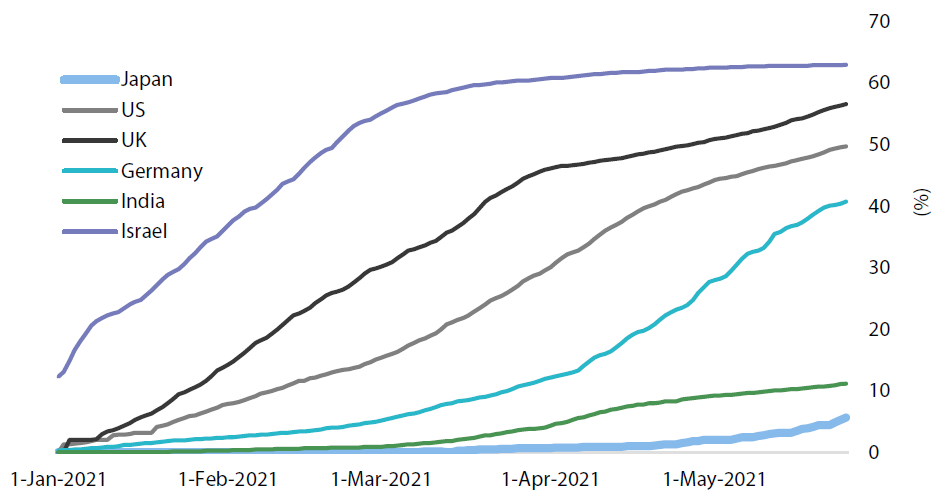 Source: Our World in Data, as at 27 May 2021
Source: Our World in Data, as at 27 May 2021
We can identify two main reasons for Japan’s slow rollout. First, it has so far been unable to develop its own vaccine and is therefore reliant on imports; in other words, it essentially needs to wait until vaccine-producing countries are first done inoculating their own populations. Japan is home to some pharmaceutical companies with the potential ability to develop COVID-19 vaccines. However, the government, unlike its peers in countries such as the US, failed to swiftly provide Japanese pharmaceutical companies with the incentives for speedy vaccine development. Second, Japan has a particularly onerous approval process for pharmaceuticals—developed because of numerous drug disasters in the past—which considerably slows the development and import of vaccines. Japan, however, is starting to step on the gas. Following a sluggish start, vaccination in Japan is finally gaining momentum (Chart 4). State-run mass vaccination centres were opened in Tokyo and Osaka, Japan’s two largest cities, on 24 May, with the government recruiting the country’s military to operate the venues. Local governments in other areas are also planning to set up their own mass vaccination sites, with baseball stadiums considered as potential venues. Stringent regulations are also being softened so Japan can deal with a shortage of eligible medical staff allowed to administer shots. Furthermore, Japan, where only the Pfizer coronavirus vaccine had been approved, gave the green light to the Moderna and AstraZeneca vaccines on 21 May.
Chart 4: Total number of vaccine doses administered in Japan
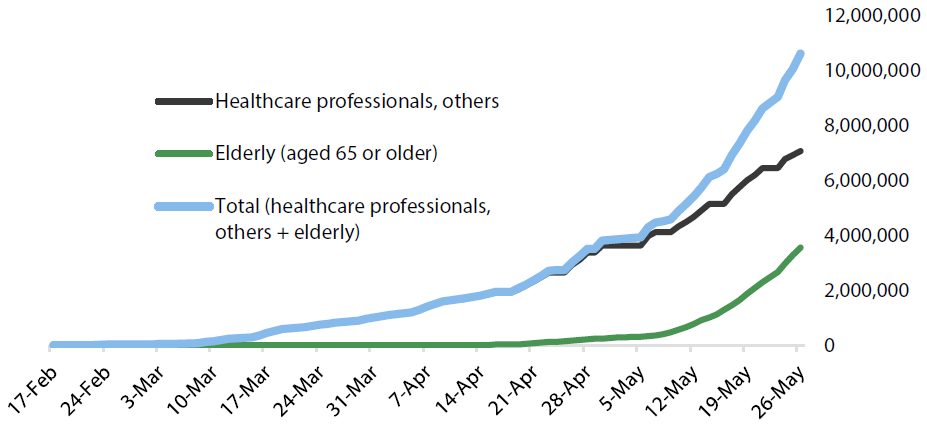 Source: Office of the Prime Minister and the Cabinet, as at 27 May 2021
Source: Office of the Prime Minister and the Cabinet, as at 27 May 2021
We believe that the Japanese equity market will be in a good position to benefit once a significant amount of vaccines are rolled out, permitting the re-opening of the economy.
Conservative guidance by companies
May was the peak of Japan’s latest full year earnings season, and a striking feature was the divergence in the earnings of manufacturers and non-manufacturers. Manufacturers, including autos and machinery, were negatively impacted by the pandemic due to operational disruptions and deflated demand early in 2020. However, the sector recovered strongly in the second half of the fiscal year (which ran through March 2021). Driven by growing demand in the US and China, manufacturers posted a 35% increase in earnings for the fiscal year through March 2021. It is also worth noting that semiconductor-related names have announced strong results thanks to accelerated use of technology and an increase in end demand. Non-manufacturers, on the other hand, struggled in the wake of the states of emergency declared in 2020 and 2021. As people were urged to stay home, the obvious losers included the transportation sector, such as railways and airliners, and restaurant chains. Companies are collectively forecasting net income growth of 28% for the current fiscal year which started in April. But we think there is potentially more upside to this number because corporations are likely being conservative with their guidance. Chart 5 shows the dividend forecasts of TOPIX-listed companies at the beginning of each fiscal year since 2010. The far-right column shows the composition of the most recent dividend forecasts in relation to the previous year. We can see that, at around 40%, the share of the companies planning to hike dividends would make it the largest such increase in the last 10 years.
Chart 5: Dividend forecasts of TOPIX companies
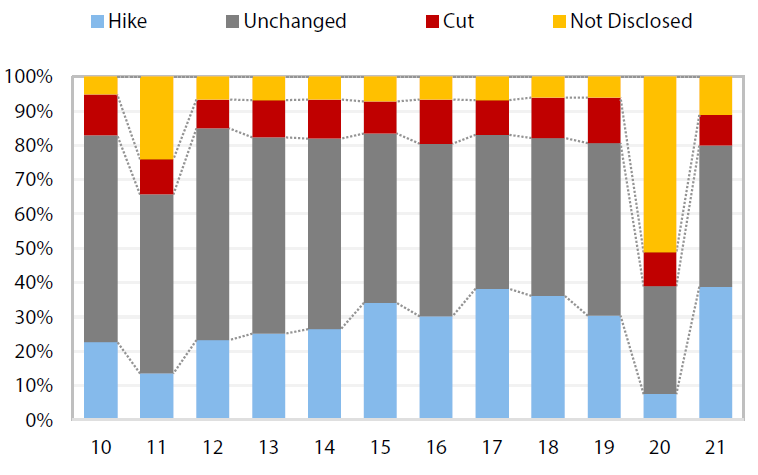 Source: Okasan Securities, QUICK Workstation, as at 11 May 2021
Source: Okasan Securities, QUICK Workstation, as at 11 May 2021
Another interesting feature is the yellow bar indicating that a relatively high number of companies have not yet disclosed their dividend forecast (although not as many as last year). This is understandable given the uncertainties surrounding the economy, but these companies have the potential to come out with dividend hikes as well. The conservative forecasts should not come as surprise when the state of emergency, the current economic situation, and the slow vaccine rollout are taken into account. Once vaccinations progress and the economy re-opens, we think the conservative earnings guidance and the dividend forecasts could be revised up towards the end of the year, and that will be positive for market sentiment.
The relevance of dividends amid prospect of higher interest rates
Japan’s current dividend yield level and the potential upside in dividends warrant attention. Chart 6 shows the dividend yields of Japan (TOPIX) and US (S&P 500). Both US and Japanese yields have been gradually declining over the past 12 months amid a rally by the markets. But as many Japanese companies are expected to hike dividends this fiscal year, Japan’s yield is higher. Chart 7 shows the relative ratio between the two markets (Japan dividend yield divided by US dividend yield); we can see that from this perspective Japan is currently more attractive.
Chart 6: Japan, US dividend yield
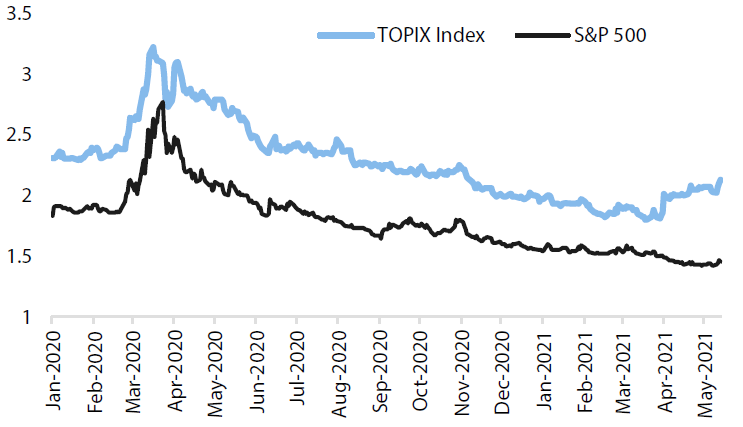
Chart 7: Japan, US dividend yield relative ratio
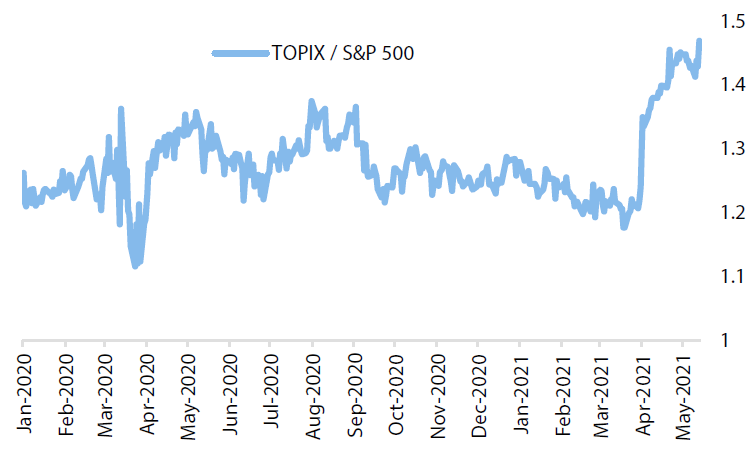 Source: Bloomberg, as at 13 May 2021
Source: Bloomberg, as at 13 May 2021
Chart 8 shows the two markets’ equity duration—that is, the number of years it takes theoretically for invested capital to be recouped (i.e., inverse of dividend yield ). Japan’s is 47 years while that of the US is 69 years. A shorter duration can be construed as less sensitivity to interest rates as the proportion of cash flows that make up a stock’s value will likely be received sooner. The Japanese equity market could therefore fare better when interest rates rise.
Chart 8: Equity duration (number of years required to recoup invested capital)
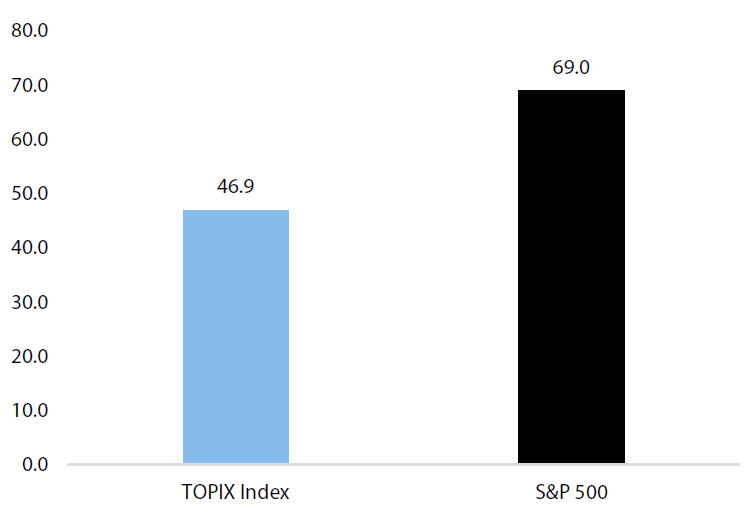 Source: Bloomberg, as at 13 May 2021
Source: Bloomberg, as at 13 May 2021
Furthermore, from a broader perspective the Japanese equity market has shown a tendency to perform better than its US counterpart when US yields are rising (Chart 9). This characteristic offers investors the option to diversify away from the US market, with its heavy exposure to the tech sector, when interest rates rise.
Chart 9: TOPIX tends to better than S&P 500 when US yields rise
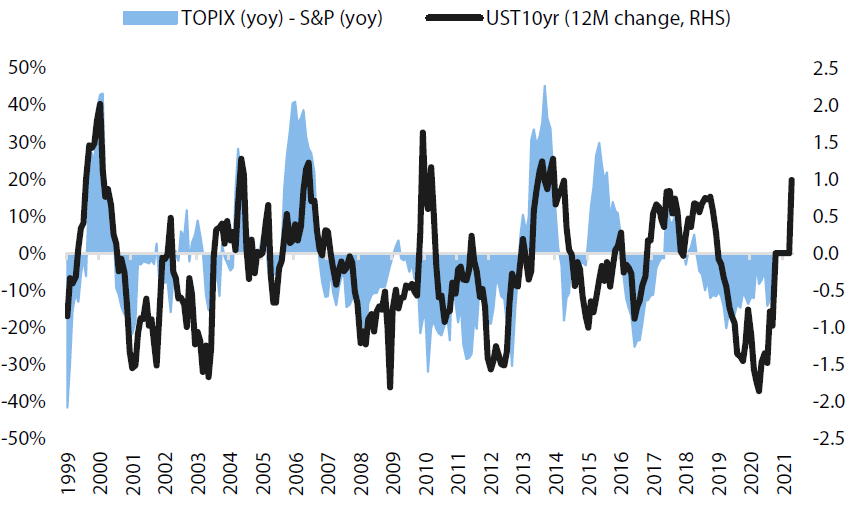 Source: Bloomberg, as at 30 April 2021
Source: Bloomberg, as at 30 April 2021
Furthermore, from a broader perspective the Japanese equity market has shown a tendency to perform better than its US counterpart when US yields are rising (Chart 9). This characteristic offers investors the option to diversify away from the US market, with its heavy exposure to the tech sector, when interest rates rise.
Summary
While the Japanese equity market is lagging its peers due to virus-related economic restrictions and a slow start to vaccinations, the market will have significant upside potential once the rollout of vaccinations gathers speed. And while recent corporate earnings expectations have been understandably conservative, a re-opening of the economy could trigger upward revisions in earnings and dividends, with the latter to become more attractive in a rising interest rate environment. Such an environment will also be conducive to a shift from growth to value, which could also benefit from secular, structural changes unfolding in Japan.






